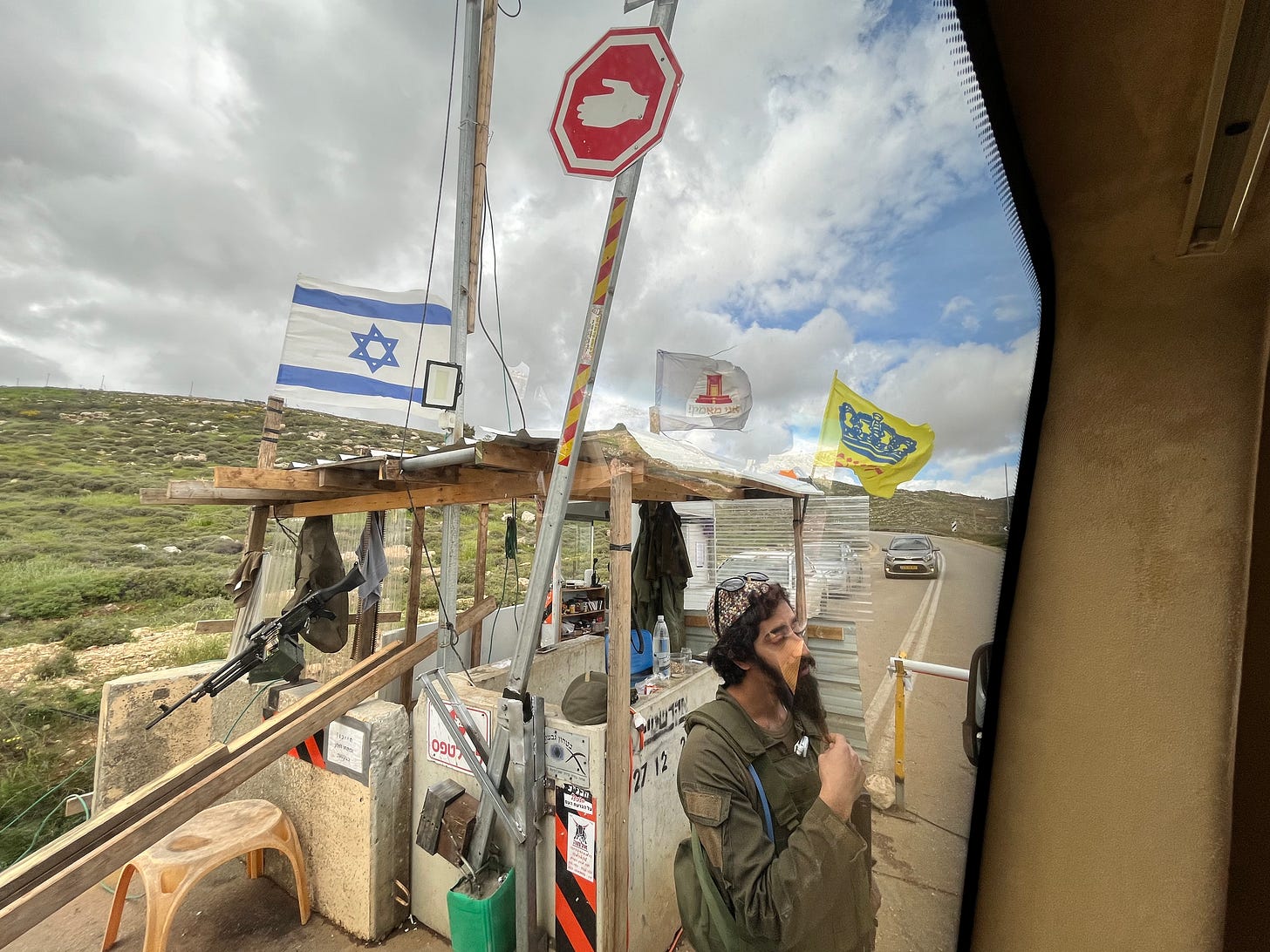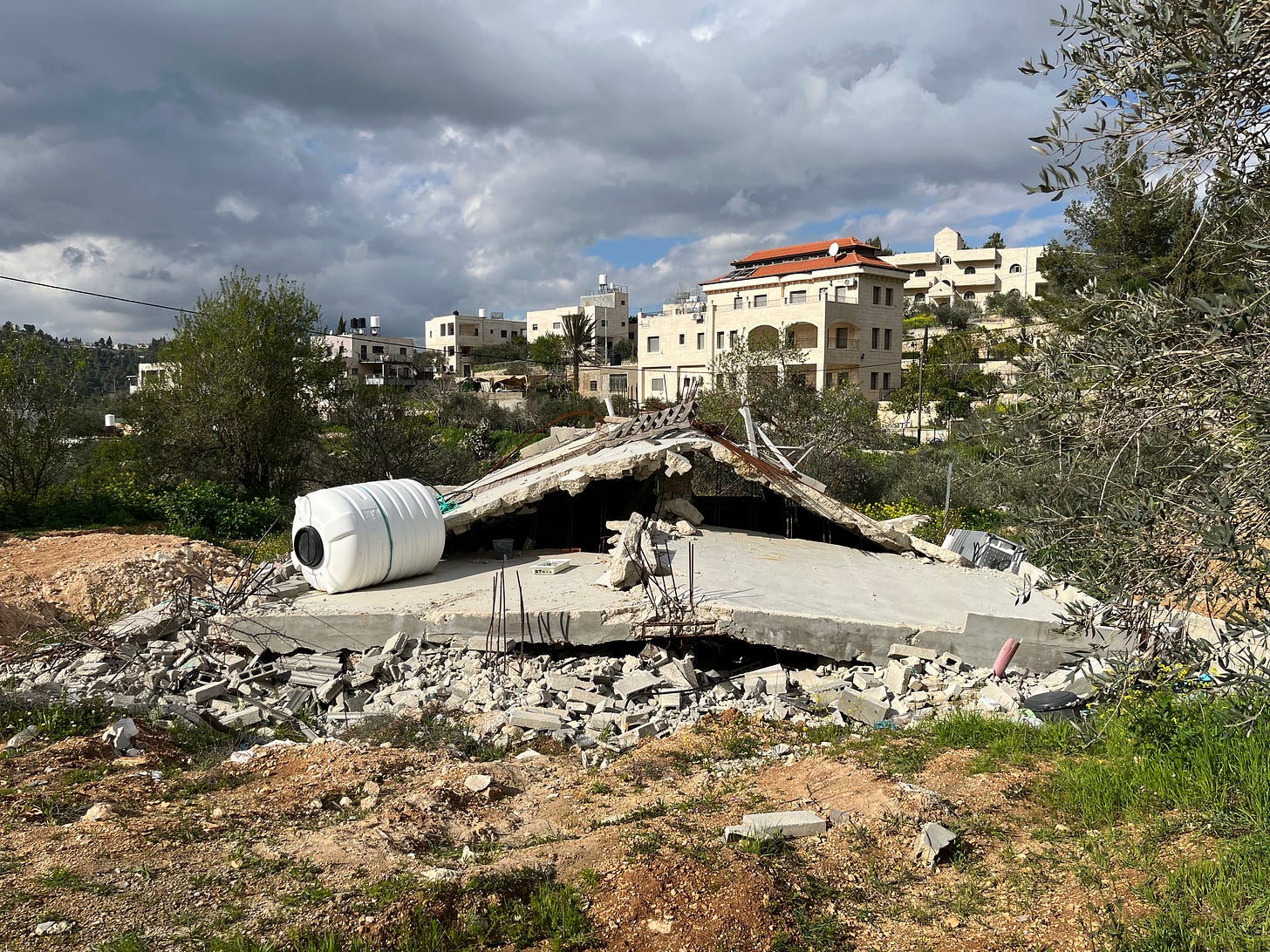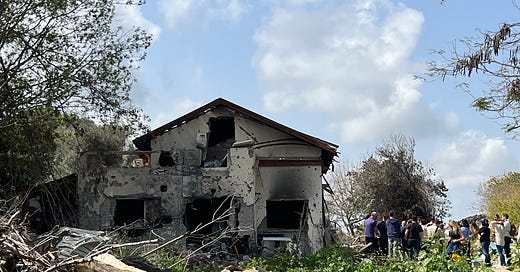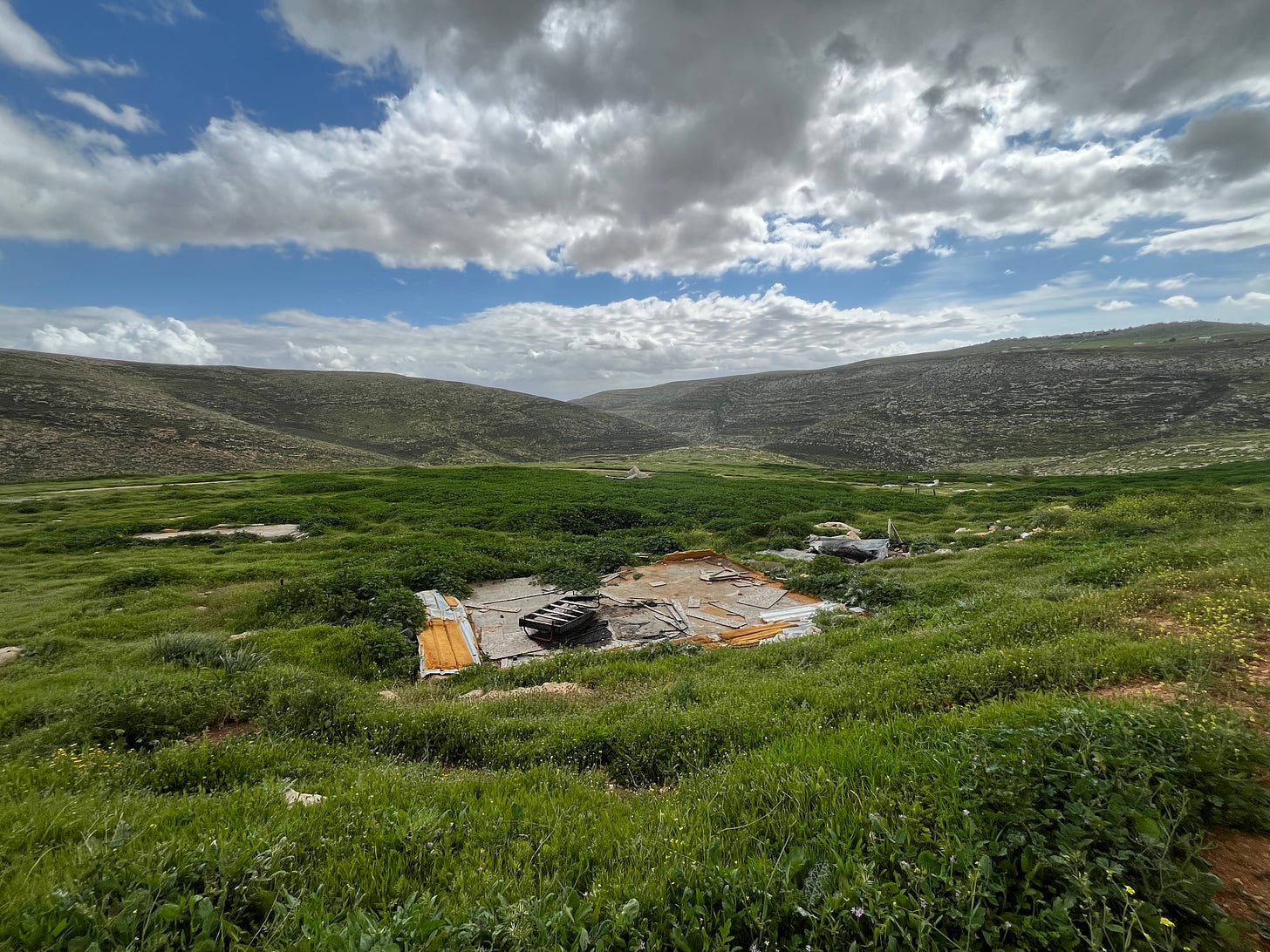Not "Sobering Up" in Israel/Palestine
The cycle of mutual destruction in three vignettes from my current trip with Americans for Peace Now.
I have seen more than my share of destruction this past week in Israel/Palestine. Three times in the last five days I’ve stood in front of wrecked houses, thinking about the ruined lives they represent. First, in the Negev desert at Kibbutz Be’eri in the south along the border with Gaza, where Hamas terrorists and other Gazans ran amok, brutally killing hundreds of Israeli civilians. Second, a day later, in the verdant mountains of the West Bank, where a village of several dozen Bedouin lay abandoned after Jewish settlers built outposts encroaching on their grazing land, choked off their livelihood and then violently intimidated them into leaving. And third, in Israeli-annexed East Jerusalem, where residents of the Palestinian village of al-Walaja cleaned out the ruins of one house that the authorities demolished last week and another stood in front of her flattened home and told us how her life was destroyed a year ago.
No, I am not suggesting that these three stories are equivalent. Hamas’s wanton murder spree on October 7 is not the precise moral equivalent of the Jewish settlement movement’s steady encroachment on Palestinian life and property, or the Israeli government’s bureaucratic imposition of sudden home demolitions on villagers whose only crime is building on their own land without a formal permit—which they can’t get because, following Kafka’s advice, the Israelis authorities refuse to produce a development plan for the village. What Hamas did in one day was crueler and more destructive. But the result is the same: more destroyed lives.
Fortunately, this week our group (which has been traveling under the auspices of Americans for Peace Now) also got to meet with many people working to construct a more positive future, one centered on equality and security for both peoples, whether that is in a two-state solution or in the development of a shared society. The sum total of those meetings offered some hope that Israel/Palestine, which is now caught in a hideous zero-sum conflict, might someday turn in a better direction. But I’d be lying if I said I am optimistic for that day. Instead, what I saw this week was how the contradictions of this place were only intensifying. Reconciling the “two tectonic plates underlying the reality of what is taking place here,” as one of our speakers put it, will take partnership, not separation.
Here are a few snapshots of that underlying reality. In my next post, I’ll try to focus on the brighter side.
At Kibbutz Be’eri last Wednesday, we walked along an alley of ruined homes, stopping every now and then to listen to our guide, Hugo, a kibbutz member, share the story of the murdered people who used to live in each. At some he told us not to take pictures, to protect their privacy. At one house, he told us how a teenaged boy jumped out of the window of his home’s safe room and then hid in the bushes for hours until he heard the Hebrew spoken by approaching IDF soldiers. He was rescued, along with his family in their safe room. But for hours, he assumed they had all been killed. They had thought the same. I stood in front of the bushes and wondered if I could had hidden in them for half a day, and if they would have even protected me from view. Every fifteen minutes or so, we heard a boom from Israeli artillery operating nearby.
Hugo, our guide, was a good representative of the Israeli who has “sobered up” since October 7, a phrase we heard often from people. That is, he once was in favor of peace with the Palestinians, but now he doesn’t believe it is possible. He told us that over the course of a week after October 7, he had managed fifty funerals for fellow kibbutz members. (I thought about all the kids in Gaza who will never have funerals, but I didn’t interrupt Hugo.) Before October, a group of members would voluntarily donate some of their salaries to be sent to Gazans who had worked on Be’eri for years before the Israeli withdrawal from Gaza, and as the community’s treasurer, Hugo managed the process. But now he sees no point to even maintaining connections with those Palestinians. “The Jewish people are being persecuted now in the same way as 80 years ago in Europe,” he told us. There is a direct line from Nazism to October 7, he said. He only felt pity for Gaza’s civilians, refugees for 80 years. “They are never coming back to their homes here,” he declared.
Walking down a tree-lined street, we turned a corner. In front of me I saw one member of our group, Kenneth Bob, the chair of the board of Ameinu, bent over in pain. We had come to the burned-out home of Vivian Silver, a well-known peace activist who had been killed. For weeks after October 7, her friends, including Ken, had held out hope that she was a hostage alive in Gaza. Only a professional archeologist was ultimately able to find her remains in the ashes of her home. Here is a short video of Hugo our guide, and then Ken, speaking about Silver’s work and legacy.
Later that day we visited Kibbutz Nirim, which had also been attacked. Arnon Avni, a 71-year-old retired graphic designer and political cartoonist who had been born on the kibbutz, described how he and his wife survived the assault with three of their grandchildren hiding in their safe room with them. Nirim’s losses were relatively light—five killed and five wounded—but the kibbutz is now mostly living in a hotel in Eilat. Avni had decided to come back and work on cleaning up his community. “I don’t know if I want to fix myself or my community,” he mused.
Avni said he rejects the “I sobered up” trend in Israel. He told us he believed that “if we do not achieve a two-state solution, we will be the people who achieved apartheid, at a time when that is not a legitimate idea any more. “You can’t rule another people forever,” he said. “If you do, you doom yourself to violence forever.”
Julia Chaitin, a retired psychologist who is an American-born member of Kibbutz Urim, which was also attacked, told us she was still in touch with some of the Gazans who she engaged with as a peace activist. But she admitted she didn’t realize how much Palestinians hated Israelis. A few years ago, she and some colleagues wrote a book called Routine Emergency: The Meaning of Life for Israelis Living Along the Gaza Border, and now they were re-interviewing the people they had profiled. Of the seventeen people they had been able to talk with, all had shifted. Before October 7, she said, these Israelis living along the border had been sympathetic to Gazans. Now they were split three ways. Some said they never wanted to see them again. Others admitted they knew what was happening in Gaza was terrible, but they didn’t have room in their hearts to feel Palestinian pain. And a third group said they hadn’t changed their minds about needing a political solution to the conflict, but that they didn’t know who to trust to get them there.
Unsettled Times
The next day we left Jerusalem for a tour of Jewish settlements in the West Bank, specifically focused on Area C. That is the 60% of the occupied territory that remains completely under Israeli control, but which also encompasses many Palestinian villages. Our guide was Yoni Mizrachi, a genial and sarcastic middle-aged professional archeologist who recently began working with Peace Now’s Settlement Watch project.
Because of heavier-than-usual spring rains, the hills northeast of Jerusalem were verdant and bursting with flowers. As we drove, Mizrachi explained how Israel was spending hundreds of millions of shekels to keep expanding settlements and accommodate the settlers, building expensive bypass roads to allow them to skirt around Palestinian towns and have a faster commute to jobs in the country’s center. He also showed us how Israel was artificially keeping the number of settlements down by calling new ones “outposts” instead of settlements, even if they were kilometers from the settlement they were supposedly part of. Here you can listen to him describe how a small Bedouin village, Ein Samya, was choked out of existence by the spread of such outposts. (Mizrachi is on the right; Ori Nir of Americans for Peace Now is on the left.)
Only the foundation stones from the Bedouin homes remain, testifying to their loss.
Since October 7, Mizrachi explained, Israel has drastically restricted Palestinian travel within the West Bank. Many communities have had their entrances blocked, forcing people to take hours-long detours to get to the larger Palestinian cities like Nablus or Ramallah. But along with the increase in settler violence against Palestinians, which mostly goes completely unpunished, we saw clear signs of how the settlers were the tail wagging the dog that is the Israeli army supposedly in charge in the occupied territories.
Traveling up the 5055 road towards the settlement of Shiloh, we hit a checkpoint manned by two Israeli settlers in army uniform. Since October 7, many reservists from the settlements are being assigned to duties near their homes. But at this checkpoint, three flags were waving. One was the familiar blue-and-white Israeli flag. The second was yellow, with a blue crown on it and the word “Messiah” in Hebrew on it. And the third showed a mock-up of a rebuilt Temple Mount, with the words “I believe!” in Hebrew below. These, Mizrachi explained, were signs of the radical movements afoot among the settlers, who have a large messianic wing that wants to rebuild the Temple that used to stand in Jerusalem, destroying the holy site of the al-Aqsa Mosque in the process.

Our bus driver rolled down his window, and one of the two soldiers tugged on his beard while he demanded to know who we were. Mizrachi explained in Hebrew that we were a group of “American donors” touring around the area, a line that usually works at army checkpoints, he told us later. Then the soldier-settler asked if there were any Arabs in the bus. Our driver said he was Arab. The soldier-settler’s decision was swift. We could not travel further. Briefly our group tried to protest, but that only made the man more belligerent, and he demanded that we stop taking pictures and hand us our phones. We backed away and chose a different path to our destination.
The line we have heard from officials of the Israeli government on this trip is that it’s not true that the settler movement is filled with violent, messianic activists. Less than half of one percent are dangerous, we were told. (This is why Mizrachi jokes about the .5 percent in the video above.) The rest aren’t violent, the rank-and-file are decent people who hate how a few given them all a bad name. But isn’t taking someone else’s land itself a violent act?
Friday we visited a different part of the occupied territories, a village called al-Walaja that is part of East Jerusalem, which was formally annexed by Israel in 1980. Many of the residents of al-Walaja are descendants of people who lived nearby in Ein Kerem, a place holy to Christians that was depopulated in 1948. Half of al-Walaja is in Area C, but the part we were visiting is in East Jerusalem and thus formally under Israeli law, which has produced a Catch-22 for its residents. In order to build on land they own, residents of al-Walaja need a building permit from the Israelis, but none are being issued because until recently, the authorities considered the area “open space” and failed to draw up its own zoning plan for the village. So people built on their land without official permission.
Since 2017, Israeli has demolished 70 such homes, more than a third of the 220 that stand on the village’s winding roads. Then, with the help of Israeli activists from groups like Ir Amim (City of Peoples) and Bimkon (Planners for Planning Rights), they managed to gain some legal footing and slowed the attack on al-Walaja. An Israeli court has given them the chance to present their own development plan for the village, something the authorities say is needed in order for building permits to be issued. And international pressure, like a letter from 53 members of Congress organized by Americans for Peace Now, has helped as well. But in the meantime, the demolitionist’s sword hangs over al-Walaja’s heads. Half of the town’s remaining homes have pending demolition orders. “The situation is very extreme,” Ibrahim al-Araj, a member of the village counsel told us. “People suffer and feel they have nowhere to go.”
In the past few weeks, ten more homes have been demolished. When we visited, a group of men were dragging debris out of a house that had been blown up a week ago, trying to save whatever was worth saving. A family of seven had lived there.
And a woman whose home had been blown up a year ago, taking with it her savings and all her plans for her children’s future, cried as she told us her story. “There are no settlements near here, no border fence,” she remonstrated. “I see the settlements. They are safe. What can’t I live like them?”

As I finished writing this post and prepared to send it out, we got word that the Israeli Ministry of Housing had commenced construction on a new settlement west of the giant Ariel settlement, just before Ramadan. As Peace Now said in a statement, “The construction of Ariel West, a new settlement deep in the West Bank, just before Ramadan and amidst the imminent danger of escalation in the West Bank and East Jerusalem, is further proof that the Israeli government is seeking violent escalation and opening a third front of war. It is also further proof, for anyone still in doubt, that it is doing all it can to destroy the possibility of the two-state solution. Israeli citizens deserve a better government, and its actions and decisions are endangering the lives and futures of both Palestinians and Israelis, as well as that of the entire region.”
While I want the hostages home as soon as possible too, it is no longer okay, if it ever was, for American Jews and their leading organizations, to stay silent about what is happening daily in the occupied territories. And it is absolutely time for President Biden to start witholding aid to Israel until these policies change.






Thank you for continuing to provide perspective and crucial detail for your readers, Micah. What you document is heartbreaking all around, but so important to hear.
Yasher Koach יישר כחך"